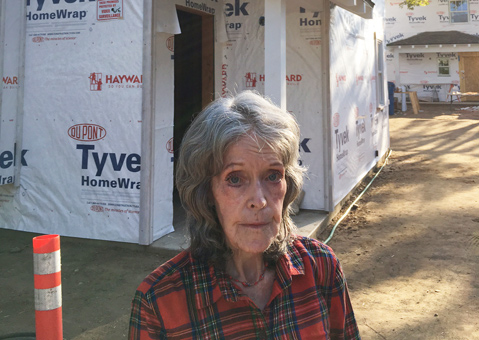‘Nightmare on De la Vina Street’
Two Veterans Face a New Foe: Looming AUD Next Door

NEW FOE: Sandra Force and her husband, George Ducott, are 100 percent disabled military vets, fighting a losing battle against a triple-threat monster that looms over their house.
While in the Vietnamese demilitarized zone back in the 1950s, George survived North Vietnamese artillery attacks, a spraying with herbicides, and being sent to command a fire base that had been overrun and everyone killed. But George and Sandra have been helpless to defeat the onslaught of a city zoning ordinance that seems to many to be veering out of control.

“Our reward for our service is the new view from our windows,” Sandra said.
On the lot next to their home at 1617 De la Vina Street sits “a six-foot cinderblock retaining wall and a claustrophobic wall of wood six feet from the property line on a construction site jammed with three two-story houses that loom like big-city skyscrapers, blocking out trees, sunsets, and even our home as you drive down the street.”
Under the much-criticized trial Average Unit-size Density (AUD) Incentive Program Ordinance, Emmet Hawkes Jr., owner of the property at 1623 De la Vina, got approval for three two-story, two-bedroom rental units instead of three studio units or two one-bedroom units, as allowed under prior zoning.
“We are improving the neighborhood,” Hawkes told me. He said he wasn’t sure of what the rents will be, but perhaps $2,400-$2,500 a month.
Only one uncovered parking space is required per building, instead of one covered and one uncovered under prior zoning, according to city staff.
“There used to be one single-story home on this small lot that had been a rental for years,” Sandra said in an angry, seven-page letter. All was relatively peaceful. Then the nightmare of construction began.
“How could the City Council allow this to happen?”
Well, to quote an old saying, “The road to hell is paved with good intentions.” A few years ago, the city, feeling the need for more affordable rental housing, figured the AUD program — allowing higher density — would reduce parking and that other incentives would attract developers.
And has it ever. An estimated 1,000 applications are in the pipeline, far exceeding practically anyone’s expectations. Despite dubious hopes that they’ll be affordable, there is no such requirement. The program is due to be reviewed after eight years or 250 units are approved.
When the city notice of a hearing arrived, “I didn’t know what to do,” Sandra told me. A U.S. Air Force veteran with a UCLA degree in linguistics, Sandra is not in good health, and George lives with severe post-traumatic stress disorder and multiple sclerosis. She didn’t realize she could have asked to be notified of further hearings. So when they happened, no one spoke.
“In 1979, I moved to Santa Barbara with my two sons and bought my home, an old two-story craftsman built in 1895. In 1984, I married my husband. That makes [many] years that I have lived here with my family: husband, children, and grandchildren. We have been very happy here — past tense.”
She calls the resulting AUD project an “ill-conceived ‘Nightmare on De la Vina Street,’ this horrible display of unrestrained greed and excess. …”
At a joint meeting of the City Council and Planning Commission last Thursday, Natasha Todorovic-Cowan of the new Citizens for Livable Neighborhoods savaged AUD. It is actually producing higher rents, and some units supposedly intended as affordable for the workforce are being turned into vacation rentals, she charged. “Two of the first four AUD rental units … have been rented as short-term vacation rentals.” They were reported as illegal in May and continue to be rented out.
She also claimed that AUD projects favor the upper income bracket while displacing current residents to make room for them.
“Existing and potential workforce housing is being lost with evictions,” and AUD is causing significant hikes in land values. As a result, rents are on the rise, she said. With a minimum of only one parking space per unit and no limit to the number of cars, there will be parking impacts for residential neighborhoods and small businesses, she warned. “Projects with five bedrooms and a single parking space have already been proposed in the AUD program.”
With the current “developer feeding frenzy,” the city is incentivizing developers at the expense of the poor, taxpayers, and renters, she charged. “AUD temporarily enriches the top 15 percent while disenfranchising the bottom 50 percent or more.”



